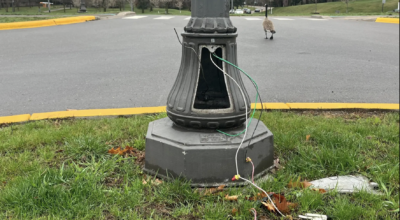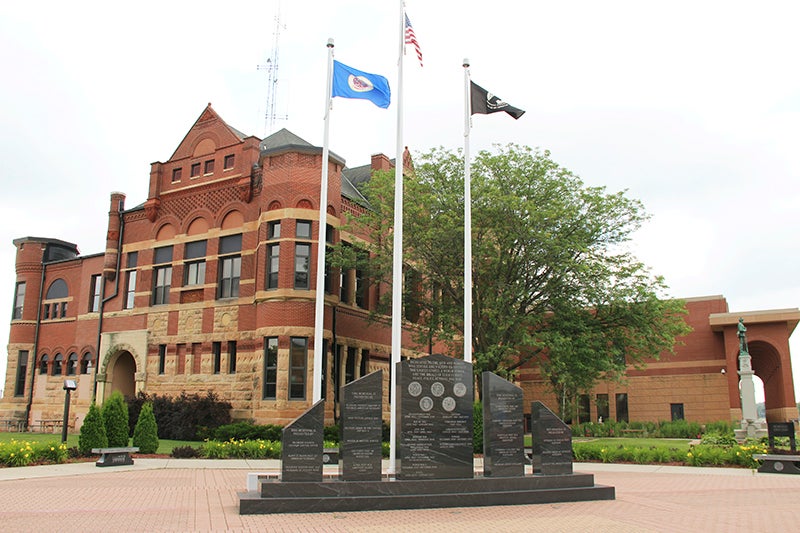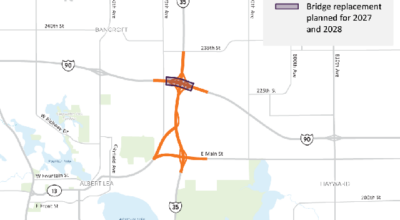27A race narrows by 1
Published 12:58 pm Saturday, November 6, 2010
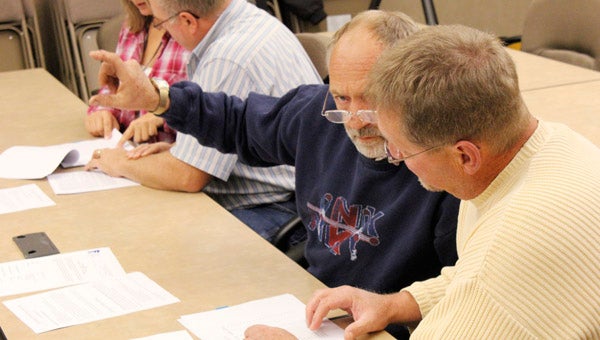
Freeborn County Commissioner Jim Nelson points while asking a question Tuesday about the number of Glenville-Emmons School District registered voters residing in Albert Lea Township. The Freeborn County Canvassing Board reviewed election abstracts Friday. -- Tim Engstrom/Albert Lea Tribune
Every vote counts.
In the House District 27A race, GOP challenger Rich Murray was leading incumbent DFLer Robin Brown by 58 votes after results were tallied on Election Night.
When the Freeborn County Canvassing Board met on Friday, however, Brown had gained one vote, narrowing Murray’s lead to 57 votes.
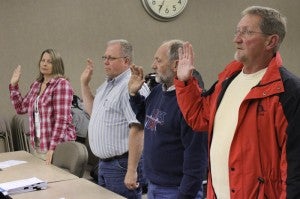
Four members of the Freeborn County Canvassing Board — left to right, Freeborn County Deputy Court Administrator Debra Miller, Albert Lea City Council member Larry Anderson and Freeborn County commissioners Jim Nelson and Glen Mathiason — hold up their right hands Friday morning and swear an oath to follow the laws of Minnesota. The meeting took place in the Freeborn Room of the Freeborn County Government Center. The board's fifth member, Freeborn County Auditor-Treasurer Dennis Distad, gave the oath. -- Tim Engstrom/Albert Lea Tribune
Freeborn County Auditor-Treasurer Dennis Distad said an absentee ballot from Albert Lea’s Ward 2, which did not get into the first set of general election results, was tallied and entered into the results certified by the Canvassing Board on Friday.
The certification of the results means that the election results in Freeborn County are now official.
But District 27A also covers Mower County.
The Mower County Canvassing Board also met on Friday morning to certify its election results. It did not choose to certify its results, however, because of a discrepancy in the number of absentee ballots listed on the state abstract.
According to Mower County Auditor-Treasurer Doug Groh, he did not sign the state abstract because it reflected the number of absentee ballots accepted as 803. He said the number of absentee ballots accepted was 826.
He said the error likely occurred during data entry by one of the precincts. His office was looking to resolve the discrepancy on Friday.
Groh also said this will not have any affect on the total vote counts, and the Mower County Canvassing Board is scheduled to reconvene on Tuesday.
“We’re just going on like this is done and we’re moving forward,” said Murray.
Because the District 27 A race covers more than a single county and is a state-level race, it must be certified by the state Canvassing Board, scheduled for Nov. 23.
A recount is expected in this race, as the margin of victory is less than 0.4 percent in the unofficial results. Minnesota law states an automatic recount is triggered when there is a margin of victory of less than 0.5 percent.
The hand recount for the House District 27A race is slated for 9 a.m. Nov. 29. And the hand recount for the governor’s race in all likelihood will happen later the same day, barring any surprises between today and the date the state Canvassing Board meets.
Brown’s campaign manager, Joseph Brown Sr., said on Friday they don’t expect any drastic changes and do believe a recount will verify the results.
“Robin isn’t going to stand in the way of the law,” he said. “It was a very close election and just goes to show how important one vote is. Every vote counts.”
High attendance as recounts looms
Before the canvassing began in Freeborn County on Friday morning, the session was moved from the Freeborn County Auditor-Treasurer’s Office to the Freeborn Room in the Government Center. Interest in a possible recount led to a higher than usual attendance. Usually only two or three election officials are in the audience. This time, news media and campaign members were watching, too.
Benjamin Kidd attended as an observer for DFL gubernatorial candidate Mark Dayton, the present leader in the narrow race over Republican Mark Emmer. He was there to report the canvassed numbers back to the Dayton campaign.
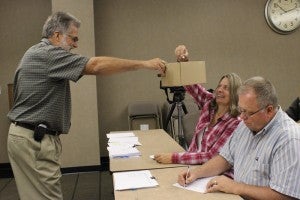
Freeborn County Auditor-Treasurer Dennis Distad holds a box for Freeborn County Court Administrator Debra Miller, who draws a slip of paper Friday that indicated ballots cast in Geneva would be reviewed as a test sample. The review specifically will be for, by statute, the races of governor and U.S. representative. The other precinct drawn Friday was Riceland Township. -- Tim Engstrom/Albert Lea Tribune
Dayton holds a lead of about 8,750 votes out of 2.1 million cast, a margin that would trigger a recount unless the official state canvass on Nov. 23 widens his lead.
Kidd would not comment as to whether the Dayton campaign had observers at any of the state’s other 86 county canvassing board meetings, or how many other observers were attending these meetings. He said he was just observing the Freeborn County numbers.
Michelle Hanson, manager for the Rich Murray campaign, was in attendance, along with former Republican legislator Paul Overgaard, who had guarded the ballot room at the Auditor-Treasurer’s Office during work hours since Wednesday morning.
“We’re just here to see if any questions pop up,” Hanson said.
The Brown campaign didn’t send guards, and no campaign member attended the Canvassing Board meeting.
“We didn’t feel like that was needed,” Joseph Brown said. “Robin has faith in her local officials.”
Canvassing procedure
The Freeborn County Canvassing Board comprised Distad, District 1 Commissioner Glen Mathiason, District 3 Commissioner Jim Nelson, Albert Lea Ward 5 Councilor Larry Anderson and Deputy Court Administrator Debra Miller.
According to Distad, the mayor of the county’s largest city is generally chosen to sit on the Canvassing Board. With the absence of a mayor in Albert Lea, and mayor-elect Vern Rasmussen not yet in office, Anderson was chosen because he is a member of the City Council, and his name was not on the ballot this election.
Miller was there in place of Freeborn County Court Administrator Kristine Maiers.
After the board members were sworn in, Distad explained the purpose of the canvassing.
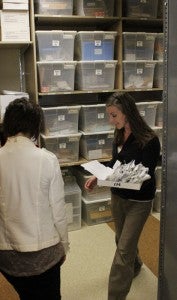
Freeborn County Deputy Auditor-Treasurer Nicole LaFrance carries an in-box Thursday from the closet where the ballots are secured in bins. Chief Deputy Auditor-Treasurer Pat Martinson holds the door. -- Tim Engstrom/Albert Lea Tribune
“The purpose is to review the totals of the county and state candidates, to certify those results and to declare the winners here in Freeborn County,” Distad said.
After Distad took a few minutes to answer general questions about the voting process, the board reviewed election totals.
The board reviewed the state and federal abstracts along with the county and school district.
The summary of statistics, a tally of the number of votes cast in person and absentee by township, was provided for the board’s information, too. It included city and county races, school board races, and questions asked in precincts.
Distad said the reports were proofed in advance to ensure correct vote totals prior to Friday’s meeting.
He also said that all ballots were reviewed by hand on election night, first by election judges at the individual polling places and then again at the Auditor-Treasurer’s Office, to ensure all write-ins were picked up properly.
Distad also said workers at the Auditor-Treasurer’s Office act as the Absentee Ballot Board, and all of those ballots were certified on election night and again Friday.
After about 25 minutes, the board completed its review and signed the state abstract.
The state abstract was then sealed and sent Friday by express mail to the Minnesota Secretary of State’s Office. A copy of the state abstract is also kept in Distad’s office.
According to Distad, school districts get their own abstracts. They also get copies of the write-in tally sheets that was received from either the Absentee Board or the precinct on election night to look over as well.
Equipment check
Distad will oversee the “post-election equipment review” scheduled for 9 a.m. Wednesday in the Freeborn Room at the Government Center. The check is open to the public.
Commonly called PEER, it is required by state law to ensure the accuracy of the voting equipment. It is not related to the pending recounts.
Two precincts were chosen at random, by drawing names from a bowl, for the PEER review: Riceland Township and Geneva.
Distad said that those precincts will be notified to bring at least two of their election judges to the review. These election judges will then count all ballots from their respective precincts, by hand, to ensure the machine tabulated the results correctly. They will compare the results, by statute, with the races for governor and U.S. representative.
Those results are also sent to the Secretary of State’s office.
Recount procedure in Freeborn County

Representing the Rich Murray campaign, Paul Overgaard sits at a desk at the Freeborn County Auditor-Treasurer's Office on Thursday, watching deputy auditor-treasurers Nicole LaFrance and Janelle Tuttle. -- Tim Engstrom/Albert Lea Tribune
The state Canvassing Board will meet on Nov. 23 to certify results statewide. This will determine whether recounts in the governor’s race and the District 27A race will take place.
If the state board proceeds with the decision to go forward with a recount, which it mostly likely will, Freeborn County’s recount will be at Nov. 29.
According to Distad, the recount in the District 27A race would be at 9 a.m. in the Freeborn Room, with the governor’s race to follow that afternoon. He said procedures for both will be exactly the same.
Distad will appoint 12 people, mostly from his staff and other county employees, to go through each ballot by hand.
Representatives from the political parties will oversee the procedures.
In the morning session, ballots will be sorted into piles by candidates: Brown, Murray, write-ins or no votes.
If they come across a ballot with a strange marking, meaning if the oval was filled in wrong, a candidate’s name crossed out or circled, the intent of the voter will be determined.
If the observers and the election judges do not agree on a ballot, Distad ultimately determines the outcome. If the representatives from the political parties do not agree with his determination, they can file their disagreement to the Secretary of State’s Office.


